
A lute is any plucked string instrument with a neck and a deep round back enclosing a hollow cavity, usually with a sound hole or opening in the body. It may be either fretted or unfretted.

The oud is a Middle Eastern short-neck lute-type, pear-shaped, fretless stringed instrument, usually with 11 strings grouped in six courses, but some models have five or seven courses, with 10 or 13 strings respectively.
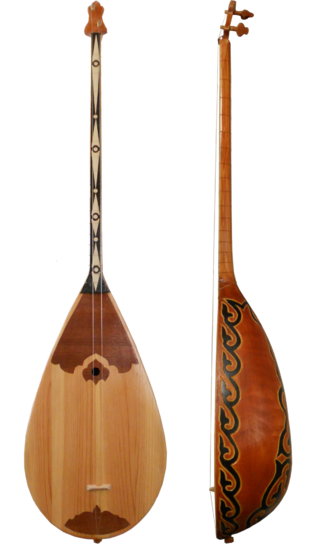
The dombra, also known as dombyra, is a long-necked musical string instrument used by the Kazakhs, Hazaras, Uzbeks, Tajiks, Nogais, Bashkirs, and Tatars in their traditional folk music. The dombra shares certain characteristics with the komuz and dutar instruments, such as its long, thin neck and oblong body shape. It is a popular instrument mostly among Turkic communities in Central Asian countries.
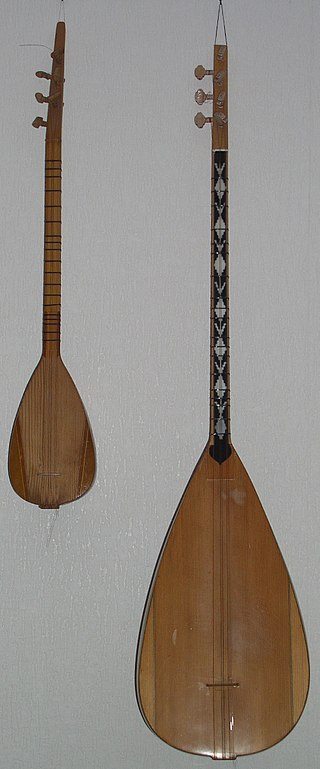
The bağlama or saz/ساز is a family of plucked string instruments and long-necked lutes used in Azerbaijan, Iran, Turkey. It is commonly used by the ashiks.
Kyrgyz music is nomadic and rural, and is closely related to Turkmen and Kazakh folk forms. Kyrgyz folk music is characterized by the use of long, sustained pitches, with Russian elements also prominent.
Music of Kazakhstan refers to a wide range of musical styles and genres deriving from Kazakhstan. Kazakhstan is home to the Kazakh State Kurmangazy Orchestra of Folk Instruments, the Kazakh State Philharmonic Orchestra, the Kazakh National Opera and the Kazakh State Chamber Orchestra. The folk instrument orchestra was named after Kurmangazy Sagyrbayuly, a well-known composer and dombra player from the 19th century.

The kobza, also called bandura is a Ukrainian folk music instrument of the lute family, a relative of the Central European mandora. The term kobza however, has also been applied to a number of other Eastern European instruments distinct from the Ukrainian kobza.

The tar is a long-necked, waisted lute family instrument, used by many cultures and countries including Iran, Azerbaijan, Uzbekistan, Armenia, Georgia, Tajikistan, Turkey, and others near the Caucasus and Central Asia regions. The older and more complete name of the tār is čahārtār or čārtār, meaning in Persian "four string",. This is in accordance with a practice common in Persian-speaking areas of distinguishing lutes on the basis of the number of strings originally employed. Beside the čārtār, these include the dotār, setār, pančtār, and šaštār or šeštār.
The musical traditions of Central Asia mirror the immense diversity found in the cultures and populations residing in the region. Principal instrument types are two- or three-stringed lutes, the necks either fretted or fretless; fiddles made of horsehair; flutes, mostly sige at both ends and either end-blown or side-blown; and jew harps, mostly metal. Percussion instruments include frame drums, Tam origin of the bowed string Use of the bowed string is thought to originate with nomads who mainly used the snake-skin, covered horsetail-bowed lute. In Mongolia instruments like the morin khuur or horse-head fiddle survive today.

The Book of Dede Korkut or Book of Korkut Ata is the most famous among the dastans or epic stories of the Oghuz Turks. The stories carry morals and values significant to the social lifestyle of the nomadic Turkic peoples and their pre-Islamic beliefs. The book's mythic narrative is part of the cultural heritage of the peoples of Oghuz origin, mainly of Azerbaijan, Turkey and Turkmenistan. Only two manuscripts of the text, one in the Vatican and one in Dresden, Germany. were known before a third manuscript was discovered in a private collection in Gonbad-e Kavus, Iran, in 2018.
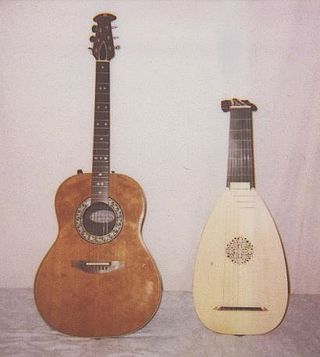
Plucked string instruments are a subcategory of string instruments that are played by plucking the strings. Plucking is a way of pulling and releasing the string in such a way as to give it an impulse that causes the string to vibrate. Plucking can be done with either a finger or a plectrum.

The kobyz or qobyz, also known as the kylkobyz, is an ancient Turkic bowed string instrument, spread among Kazakhs, Karakalpaks, Bashkirs, and Tatars. The Kyrgyz variant is called the kyl-kyiak).
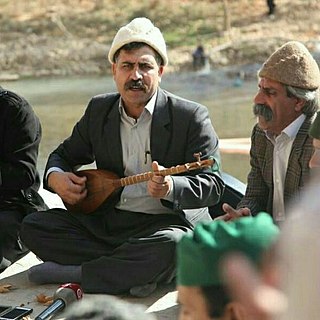
The term Tanbur can refer to various long-necked string instruments originating in Mesopotamia, Southern or Central Asia. According to the New Grove Dictionary of Music and Musicians, "terminology presents a complicated situation. Nowadays the term tanbur is applied to a variety of distinct and related long-necked lutes used in art and folk traditions. Similar or identical instruments are also known by other terms." These instruments are used in the traditional music of Iran, Iraq, India, Armenia, Afghanistan, Azerbaijan, Pakistan, Turkey, Tajikistan, Kazakhstan, and Uzbekistan.

The temir komuz is a Kyrgyz jaw harp, while the komuz is a three-stringed fretless lute. As an instrument, the temir komuz is unrelated to the komuz in terms of style and structure; however, it takes its name from the other popular Turkic instrument.

The dutar is a traditional Iranian long-necked two-stringed lute found in Iran and Central Asia. Its name comes from the Persian word for "two strings", دوتار do tār, although the Herati dutar of Afghanistan has fourteen strings. Dutar is very popular in Tajikistan and Khorasan province of Iran. When played, the strings are usually plucked by the Uyghurs of Western China and strummed and plucked by the Tajiks, Turkmen, Uzbeks. Related instruments include the Kazakh dombra. The dutar is also an important instrument among the Kurds of Khorasan amongst whom Haj Ghorban Soleimani of Quchan was a noted virtuoso. In Kurdish one who plays the dutar is known as a bakci (bakhshi) similar to Turkmen bagşy, while in Azeri the term is ashiq. Khorasan bakhshi music is recognized on the Representative List of the Intangible Cultural Heritage of Humanity.

The Huobosi is a stringed musical instrument from China. The name is a transliteration into Chinese of a medieval Turkic name for the instrument.
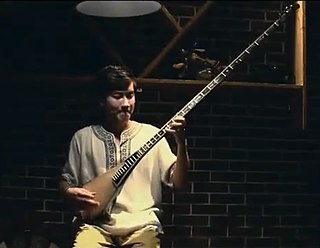
The tembor is a long-necked lute used in the music of Xinjiang, a diverse region of western China. Specifically, it is used by the Uyghur ethnic group.
The kumuz or agach-kumuz is a stringed instrument used by the Kumyks of Dagestan, in the Russian Caucasus. It has three strings and is fretted. Scholars have noticed the similarity in name to the Kyrgyz komuz, but note the kumuz is perhaps more closely related to the other lutes of the Caucasus.

Lutes are stringed musical instruments that include a body and "a neck which serves both as a handle and as a means of stretching the strings beyond the body".



















